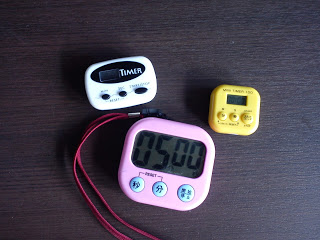Digital Timer
The digital timer is an essential tool for parenting.
A digital timer helps young children keep track of time. One of the thing which parents need to teach their children is the concept of limited resources, like time. Young children are not tardy because they are trying to waste time. They are tardy because they do not have a sense that time does not stand still for them. (Many adults are like that too!)
Another reason the timer is useful is that it is an objective tool and helps the parent stay objective. In our family, we will give the children time limits for activities, for example, they are given a 5-minute warning for end of play. We will then set the timer. Once the timer goes off, the children stop – they cannot argue with the timer. If the children feel that they need more time, they would appeal for more time, before we set the timer. It teaches the children to consider, plan and negotiate.
The timer helps the parent keep track of time. After setting the timer, it frees me from watching the time for them, and I can continue to do my own things.
We bought our first timer from a convenience shop nearby our place – it costs $5. We just bought another two from Daiso and the children are all excited that they now each have a timer. Here are some ways in which we use it:-
1) We use it to set “5-minutes” warning, or “x-minutes” playing time.
2) We use it to set time limit for the certain activities, like meal time or work time. For meal time, we will set the time for 20 minutes on the countdown mode. After the 20 minutes, we will set it on the countup mode. The intention is to let the children know how much time they are “wasting” on dawdling, beyond the 20 minutes.
3) We use it to calculate how much time they spend on certain activities, e.g. in the toilet or the bathroom. Again, it is to give the children awareness of how much time they are spending on their activities.
The timer is not meant to control the child or make them follow our schedule. We should give children reasonable amount of time to complete their activities and every child and every family is different so we should be flexible. The ultimate aim is for the child to understand the importance and limited nature of time. Giving each child his own timer, and teaching him to use it gives him ownership over his own time. It also helps in teaching young children maths!

